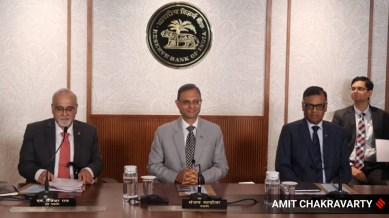100 bps cut in cash reserve ratio to boost liquidity, lower cost of funds
CRR is the portion of bank deposits to be kept with the RBI. It does not carry any interest rate. The cut in CRR cut and Repo rate is expected to bring down interest rates in the financial system.

The Reserve Bank’s move to gradually lower the cash reserve ratio (CRR) of banks by 25 basis points in four equal phases to reach three per cent by the end of the year is expected to boost liquidity in the financial system. This, in turn, should reduce funding costs for banks, making borrowing cheaper for consumers and businesses, thereby encouraging private investment and domestic spending.
CRR is the portion of bank deposits to be kept with the RBI. It does not carry any interest rate. The cut in CRR cut and Repo rate is expected to bring down interest rates in the financial system.
monthly limit of free stories.
with an Express account.
According to Binod Kumar, MD and CEO, Indian Bank, CRR cut will provide liquidity at the hands of banks. “We will ensure to pass on rate transmission immediately to support entrepreneurs and keep the economy moving forward,” Kumar said. “We see this as an opportunity to step up credit deployment, especially towards productive sectors and retail demand, while continuing to support MSMEs, retail, agri and other priority segments,” said Ashok Chandra, MD and CEO, Punjab National Bank.
The cut in CRR would release primary liquidity of about Rs 2.5 lakh crore to the banking system by December 2025, RBI Governor Sanjay Malhotra said. Banks can lend this money which otherwise wouldn’t have fetched them any return as CRR deposits with the RBI.
“Besides providing durable liquidity, it will reduce the cost of funding of the banks, thereby helping in monetary policy transmission to the credit market. I would like to reiterate that we will continue to monitor the evolving liquidity and financial market conditions and proactively take further measures, as warranted,” Governor said.
Malhotra said the comfortable liquidity surplus in the banking system has further reinforced transmission of policy repo rate cuts to short term rates. “However, we are yet to see a perceptible transmission in the credit market segment, though we must keep in mind that it happens with some lag,” he said.
Lower rates will spur the retail demand especially for affordable housing. Good monsoon coupled with lower rates augurs well for agriculture sector. It will drive consumption and will boost rural demand. “MSMEs, which are vital to India’s economy, will see improved cash flow and more room to grow,” Kumar said.
With a cumulative 100 bps cut in Repo rate over just four months, the central bank has frontloaded its easing cycle. However, by reverting its stance to neutral, the RBI signals that it may now pause to assess the full transmission of these cuts before considering further action.